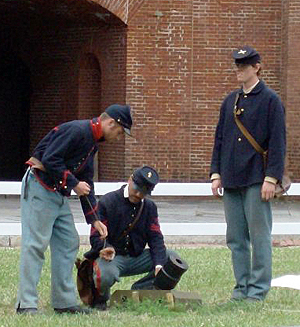
ADVERTISEMENT
2:30 p.m., Dec. 4, 2009----Brett Truitt, a senior majoring in history at the University of Delaware, writes about his summer internship portraying Union private A. J. Hamilton at Fort Delaware, which was a prison for Confederate soldiers during the Civil War, on Pea Patch Island in Delaware Bay off Delaware City. For more information about the UD History Department and its summer internship opportunities, visit this Web site.
I find myself today sitting in the Sally Port, the main entrance of the fort, looking over the horizon toward Delaware City and that wonderful Valero refinery. I think to myself how incredibly hot it is in this wool uniform, and I take a sip of water from my canteen.
When I look back up, I notice a Confederate prisoner making his way down the path from the Confederate barracks towards the fort. As he moves closer to my position, I yell to him to present his work pass. The only reason a Confederate prisoner should be in the fort is if he were to be doing work, and if so, he would have a work pass.
He searches through his pockets in a nervous way and then states he does not have a work pass. By the time I have my bayonet fixed, readying myself to move “the Johnny” along, he finally finds his work pass and presents it to me with the look of success on his face. I thoroughly examine the piece of paper, which seems to be legitimate, and proceed to let him by. Just another typical day at the fort.
When working at Fort Delaware, I notice how everyone strives for precise historical accuracy. Phrases like “that's not period correct” and “that guy is so farby,” a term used to describe historical inaccuracy, are used in day-to-day conversation. The Fort Delaware Historical Society has put a lot of time into researching information for the fort, thereby enabling interpreters like me to create a character and present him as he goes throughout his daily activities.
In the fort's office, there are files upon files of different Union and Confederate soldiers who were held at the fort. They include everything from personal diaries, like the one written by A. J. Hamilton, the person I portrayed, to letters with just a bit of information on them. We use all of it to help us portray the people at Fort Delaware.
When presenting information to the public, we use hands-on activities and presentations such as the rifle demonstration, the artillery drill, and the kids drill. Using the artillery drill as an example, we take volunteers from the crowd and teach them how to load and fire a 32-pound seacoast gun. This is one of my favorite events because of the public's unfamiliarity with Civil War artillery, and the opportunity for us to teach them. The procedure for loading and firing the artillery piece is derived straight from the artillery handbook issued for Union soldiers.
Teaching people about history as if we were in 1864 was a major accomplishment for me this summer. The one thing that made my experience amazing was the people I worked with at the fort. Their personalities and dedication to the job make the fort what it is today.



